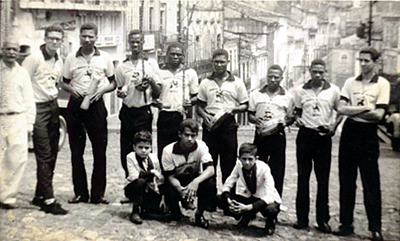
I’m losing track of time down here. On one hand the days pass quickly, but on the other hand each day is so packed with interesting experiences that each seems like more than a day.
My Independent Research Project is really taking off in ways I never could’ve imagined. I’m really happy I decided to do a comparison on the idea of malícia between the two groups, because tons of material has been written on malícia in general, but I haven’t seen anything comparing different viewpoints on it by different styles, except for a blanket statement by Mestre Bola Sete saying “malícia is less valued in Capoeira Regional than in Angola” which, after reading the picture he paints of Regional, I believe is based on an inaccurate view of the style.
Also, much has been written by historians on malícia in the daily lives of capoeiristas in the past, both during slavery and in the early 20th century, but very little, if anything, on the same subject today. Thus, my research is exploring a new area, which enables me to be much more excited about it because I hate “research” that is just rehashing work that’s already been done. I’ve already learned a ton of intriguing stuff, yet I have the sense that it’s just the tip of the iceberg.
I really wish you could be here to see the rodas of FICA (the Angola group) because they are absolutely amazing. First of all, the music is incredible; a full orchestra (meaning 3 berimbaus of different sizes/tones, two pandeiros, an atabaque [drum], agogo [cowbell] and reco-reco [scraper-thing]) and some very talented students. The things they do with the berimbaus are unbelievable, and altogether it results in very rich, very complex, very varied instrumental music.
The singing is good too, Mestre Valmir has a great voice. I’ve been playing my berimbau just about every day, working on the 6 toques (rhythms) that I know, and singing at the same time. I can see improvement: I’m getting better control of the berimbau and I can keep going for longer.
Anyway, back to the FICA rodas – each game lasts at least ten minutes, giving time for the personalities of the players to really show through and their interaction to develop well. And the complexity of that interaction is incredible too, a constant dialogue of movements, every movement requiring a response from the other player. Whoever called Capoeira Angola the “slower” capoeira only did so because Regional never really slows down, whereas in Angola the speed varies the full spectrum, from extremely slow to lightning fast. There are so many tricks and catches that I can’t even see or process them all. Add to that the ridiculously fun atmosphere of the roda; even when things get intense and a bit aggressive physically, it always, without fail, results in a round of laughter from the mestre, the players, and the spectators. They know how to play cleverly, play hard, play with malícia, without losing the brincadeira (playfulness).
Capoeira Topázio’s rodas, on the other hand… last night’s I just watched and didn’t play. The music is weak, and lots of the games get really competitive and aggressive without that sense of joy that the FICA capoeiristas have. Direct attacks and wrestling matches are common, and there isn’t really smiling or laughing. A lot of the capoeiristas seem to enter the roda looking for a fight, or looking to prove themselves better than the other guy.
Last night, several wrestling matches had to be broken up because they were getting too serious, including one between two women (interestingly, FICA is about half and half gender-wise, whereas Topázio is only 15% or so women). Mestre Dinho gave a lecture on not hurting each other, but it seems his students aren’t really taking it to heart. A couple of Topázio students who also play at the Mercado Modelo were encouraging me to go play against another girl and teach her a lesson by taking her down, because “you’re Topázio, it’s in your blood” – I’m not a fan of that one-upsmanship attitude.
I think one problem with Topázio is that Mestre Dinho himself rarely teaches classes; in all the times I’ve been there over the last 3 weeks I’ve only had one class with him, the rest are with senior students. Mestre Valmir of FICA, on the other hand, teaches every class personally, so he can make sure everyone’s learning the right attitudes.
As for the capoeira at the Mercado Modelo, that continues to be really fun! I love all the boys there, they’re really encouraging, and yes, they do occasionally take me down, but never in a mean-spirited manner; if anything they’re over-careful not to hurt me. There are some interesting issues with the capoeira there though. I had to bring a copy of my passport to register my identity with the Mercado Modelo administration; they are making all the capoeiristas register because they were having problems with capoeiristas playing there who were in trouble with the law – last week apparently the police showed up to wait for one guy, who never showed because he had some inside tip they were waiting for him, but the police took his brother or something. Luckily, Mestre Gajé’s group is a good one… when he finds out someone is in trouble with the law, he doesn’t let them play in his roda.
The sheer complexity of the capoeira culture here continues to blow my mind. So many groups… you have some groups which no one likes except the memebers of that group. One was apparently founded to unite capoeiristas of different styles in one group under one name (which personally I think is both impossible and inadvisable, considering the wide diversity of styles, teaching methods, and viewpoints – trying to standardize capoeira like that would be like forcing everyone to give up their own language and speak only English. Makes communication easy, but you lose a lot), and when I tell people I train with _______, I get one of two reactions – “rock on, my sister in ________!” from fellow students of that group, or “ohhhh…” and a wince from non-________ students. Regarding different groups, I like the point of view that Mestre Valmir has – he said each group has its value, which group is right for you depends on you, and what you’re looking to get from capoeira.
One thing that’s also interesting is how capoeira is a very real form of economic survival for a lot of people. Capoeira gave C. the opportunity to perform in Spain (he’s leaving the end of this month), and he’ll be sending the money back to Brazil to support his family here. Or W., who because of capoeira got the chance to tour abroad and earn enough money to buy his own place. Right now he teaches capoeira classes and may be getting a job with another show.
On the other hand, though, he says capoeira isn’t really good as work in Brazil, because 1) the market’s flooded with skilled and capable capoeira teachers/performers; and 2) the people of Brazil don’t really value it. He said that he’d really like the opportunity to open an academy in another country, but if that doesn’t happen, he might not be playing anymore by age 30, might try to move on to something else. There is a LOT more to be said on this but I don’t have the time to write it all!


